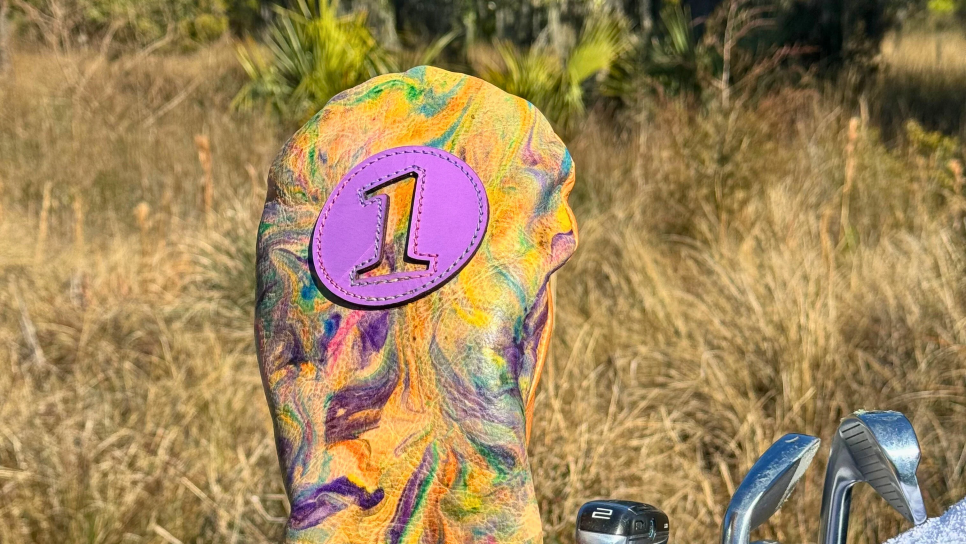Lucky Break
The unlikely story of a man who quit his job to make leather headcovers and succeeded

Bluetross' custom-made Italian vachetta leather headcover retails for $195.
Golf Digest's ongoing “Lucky Break” series chronicles the key moments that have launched golf businesses to success. For boutique custom-headcover maker Bluetross, Golf Digest turned out to be the lucky break. In late 2023, we were planning the cover image for the latest iteration of the Hot List equipment guide. The call was made to show a bespoke headcover emblazoned with year and title in striking orange over black. Enter Marc Hanson, who started Bluetross after getting hooked on leathercraft in an unexpected way.
Hanson had moved into customer management for a global healthcare company after retiring from the Navy as a lieutenant commander in 2014. The pandemic both packed his clients' calendars and freed up his as travel was restricted. "I had time on my hands that I wasn't using, and I was trying to think of something to get my brother for Christmas," Hanson says. He decided to try to make a barrel-type headcover in the style of makers like Seamus out of a keepsake pin flag his brother had given him years ago from an outing at Newport Country Club. After a month of trying—and destroying an antique sewing machine his now-wife had received from her grandmother—Hanson had found what would become his vocation.
The Golf Digest commission put a spotlight on what has mushroomed from a hobby into a business that allowed Hanson to quit his "real" job in February. Bluetross' covers might come in the same shape as the ones included with that $600 driver you just bought, but that's where the similarity ends. Hanson sources premium Italian and Horween leather commonly found in luxury handbags and hand makes headcovers designed to acquire patina and improve with use, making them $200 accessories that last far longer than the clubs they're protecting.
The price tag can seem steep, but Hanson believes you get what you pay for. "The leather you see in most sneakers, for example, is what's known as 'chrome tanned,' and it has a plastic coating sprayed on it for durability. If you scuff that coating and the leather itself, there's no way you're ever going to fix it or make it look good," he says. "But think of an expensive pair of dress shoes. That vegetable tanned leather can be buffed and polished, and those shoes can look as good or even better 20 years down the road than when they were new."
Open a shipping box with a Bluetross headcover in it, and the rich, unmistakable smell of fine leather floods out. The covers feel substantial and feature handmade patches and stripes of contrasting leather, fine details like color-coordinated lining and laser engraving that is more durable than embroidery. "I like to say our stuff wears in, not out. I want people to throw it on the ground, onto the wet grass when they're dew sweeping in the morning," Hanson says. "That's just going to make it look better three years from now. Put a little neutral shoe cream on it every once in a while, and buff it out, and it could go to your grandkids."

His lucky break: A Bluetross leather headcover was used to help illustrate Golf Digest's 2024 Hot List cover.
The Hot List cover might have been the first time many golfers saw a Bluetross cover, but they had already been in demand around Hanson's Charleston, S.C., home base. Bluetross has made member-guest gifts for the Daniel Island Club the past three years, and Hanson introduced an innovation there that expanded his product line and showed off his craftsmanship. Players could choose between a headcover or a leather tote bag designed to be given as a token of appreciation to a significant other stuck with extra child-care duty during the four-day event. "We have people come and register and ask, ‘So what do you have this year because my wife said I have to get her another bag,’ " Hanson says. "That's very affirming to know you're making something somebody truly appreciates."
Hanson sells some stock pieces from the Bluetross website but also takes commissions where he riffs on a customer's preferred color scheme. "I make a mockup and send it back, and we go back and forth until they approve the concept," Hanson says. "Then I send an invoice and get to work." Patches, stripes and the Bluetross leather tag get attached to the base leather, which is cut into the headcover blank. The lining of the cover is always color coordinated to the exterior design. From end to end the process to make a cover by hand takes between an hour and 90 minutes, depending on the complexity of the patches or logo. There's no vast assembly line in Hanson's garage, so there's a hard cap on the number of pieces he can turn out in a week.

One of Bluetross' hand-dyed leather headcovers.
In addition to keeping up with the tide of new orders—lead times have increased to four weeks—Hanson must carefully manage his inventory of leather. He keeps one hide of each stock color he offers for each of the three varieties of leather used in covers, bags and accessories like yardage book covers. The varieties range in thickness, firmness and finish and give Hanson a color and three-dimensional cutout palette from which to work. One small section of hide can cost upward of $300 from his supplier, and the construction process involves using an industrial stitching machine to make and reinforce seams and produce fine detail like contrast stitching across two different textures of leather. Taking an order with a non-stock color or many individual pieces requires careful supply chain management—a talent Hanson acquired when he was managing logistics for fleets of nuclear-powered vessels in the Navy.
Hanson's ambition? Grow in a way that lets him add local artisans and preserve handmade quality at a scale that makes it possible to feed larger clients like destination resorts. It's a long way from shining his own shoes in basic training—and from burning up the motor on an old keepsake Singer.


